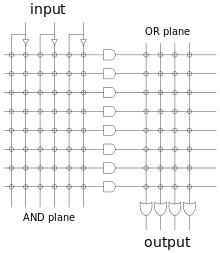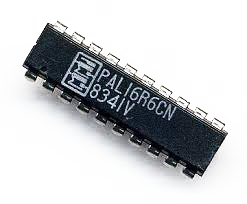
Comparison Between PLA and PAL: Which One is Right for You?
September 04 2023 
Inquiry
Global electronic component supplier AMPHEO PTY LTD: Rich inventory for one-stop shopping. Inquire easily, and receive fast, customized solutions and quotes.
QUICK RFQ
ADD TO RFQ LIST
Programmable logic devices (PLDs) are integrated circuits that can be configured to carry out a number of different digital logic operations. They are used in a variety of applications, from straightforward logic gates to intricate systems. Programmable logic arrays (PLAs) and programmable array logic (PALs) are the two primary categories of PLDs. PALs are more complicated than PLAs, which are the most basic kind of PLD.
What is Programmable Logic Arrays (PLAs)?
A programmable logic array (PLA) is a kind of programmable logic device and it is used to implement combinational logic circuits. An output can be created by conditionally complementing a set of programmable AND gate planes, a set of programmable OR gate planes, and a set of programmable AND gate planes in the PLA. It has 2N AND gates for N input variables and should have M OR gates with programmable inputs from all of the AND gates for M PLA outputs. Numerous logic functions can be created using this pattern in the sum of products canonical forms. In contrast to programmable array logic devices (PALs and GALs), PLAs include programmable AND and OR gate planes.
What is Programmable Array Logic (PALs)?
A Programmable Array Logic(PAL) is a PLD (Programmable Logic Device) circuit that functions likewise to the PLA. Unlike PLA, PAL has fixed OR gates instead of programmable AND gates. It uses two simple functions, where the maximum number of product terms that may be created in the SOP representation of the function depends on the number of linked AND gates to each OR gate. The resulting product term is not shared with the output functions even though the AND gates are always connected to the OR gates.
PLAs vs PALs
The main distinction between PALs and PLAs is the OR gate array. The OR gate array in PALs is fixed, whereas the OR gate array in PLAs is programmable. This difference makes programming PALs easier than PLAs. PLAs are able to implement a wider variety of logic operations than PALs. In addition to the aforementioned issue, PLA and PAL differ in the ways listed below.- PAL is more responsive than PLA. In contrast, PAL runs more quickly than PLA.
- The complexity of PLA is greater than that of PAL. Comparatively, PAL's complexity is less than PLA's.
- The PLA proceeds gradually. Contrastingly, PAL moves quickly.
- The price of PAL exceeds that of PLA. As opposed to PLA, PAL is less expensive.
- The PLA has greater adaptability than PAL. While PLA is more versatile than PAL, the reverse is true.
- The PAL offers greater convenience in terms of production and accessibility. Contrarily, it is challenging to access the PLA.
- In PLA, very few functions have been put into place. On the other hand, the vast majority of PAL's features are now operational.
Video related to PLAs vs PALs
Features of PLAs and PALs
Features of PLAs
- An AND array and an OR array make up a PLA, a form of Programmable Logic Device (PLD).
- The product terms of the desired logical function are produced using the AND array.
- The PLA's output is created by combining the product terms using the OR array.
- The connections between the gates in both the AND array and the OR array are programmable, allowing for the implementation of many logical operations.
- When flexibility is crucial, like in computer CPUs and other digital logic circuits, PLAs are frequently utilized.
- PALs are cheaper and faster than PLAs, but PLAs are more flexible.
Features of PALs
- An AND array and a fixed OR array are the components of a PAL, a particular kind of PLD.
- In contrast to the OR array, the AND array can be programmed.
- It is possible to create the desired logical function's product terms using the AND array.
- To combine the product terms and create the PAL's output, a fixed OR array is used.
- PALs are frequently employed in small, inexpensive applications like embedded systems where speed or cost are more essential than adaptability.
- However, PALs are less flexible than PLAs despite being cheaper and faster.
What are PLAs and PALs used for?
PLAs Applications
Although PLAs are slower and more expensive than PALs, they are more adaptable. They are frequently employed in applications where flexibility is crucial, including computer CPUs and other digital logic circuits. Here are some specific examples of applications for PLAs:- Computer CPUs: The control logic of computer CPUs is implemented by PLAs. The control logic must be able to implement a wide range of logical functions because it is in charge of choosing which instruction will be performed next.
- Digital logic circuits: A range of digital logic circuits, including decoders, multiplexers, and registers, are implemented using PLAs.
- PLCs, or programmable logic controllers, are used to operate industrial equipment. Because PLAs are adaptable and dependable, they make a strong choice for this application because they can execute a wide range of logical operations.
PALs Applications
PALs are quicker and less expensive than PLAs, but they also have less flexibility. They are frequently employed in applications where speed or cost take precedence over flexibility, such as embedded devices and other compact and affordable software. Here are some specific examples of PAL applications:- Embedded systems: Numerous products, including autos, appliances, and toys, use embedded systems. PALs are an excellent option for this application because they are tiny and quick, and they also need to be cheap.
- Instrumentation: Instrumentation is used to monitor and regulate physical processes. PALs are an excellent option for this application since they are accurate and dependable in addition to being simple to use.
- Telecommunications: A variety of traffic must be handled by telecommunications networks. PALs are an excellent option for this application because of how quick and scalable they are.
PLAs and PALs Examples
PLA Example
The PLA that may be used to implement the logical operation XOR is shown in the example below. The AND array includes 4 product terms (AB, A'B, AB', and A'B') and 2 inputs (A and B). The OR array has 1 output and 4 inputs (the 4 product terms).AND Array
------------
A | B | AB | A'B | AB' | A'B'
-- | -- | -- | -- | -- | --
1 | 1 | 1 | 0 | 0 | 0
1 | 0 | 0 | 1 | 1 | 0
0 | 1 | 0 | 1 | 0 | 1
0 | 0 | 0 | 0 | 0 | 1
OR Array
------------
AB | A'B | AB' | A'B'
-- | -- | -- | --
1
By establishing the proper connections between the AND array and the OR array, this PLA may be programmed to carry out the XOR function. For instance, we would establish the link between the AB product term and the OR array's output in order to implement the XOR function.PAL Example
The PAL that can be used to implement the logical function AND is shown in the example below. A and B are the two inputs, and AB and A'B are the two product terms. The OR array has one output and a fixed two inputs (the two product terms).AND Array
------------
A | B | AB | A'B
-- | -- | -- | --
1 | 1 | 1 | 0
1 | 0 | 0 | 1
OR Array
------------
AB | A'B
-- | --
1
By establishing the proper connections between the AND array and the fixed OR array, this PAL may be programmed to carry out the AND operation. For instance, we would establish the link between the AB product term and the OR array's output in order to create the AND function.Pros and cons of PLAs and PALs
Pros and cons of PLAs
Pros:- PALs are more adaptable
- Can do a greater range of logic operations
- Can be applied to more sophisticated applications
- Greater in cost than PALs
- More difficult to program
Pros and cons of PALs
Pros:- More affordable than PLAs
- Easier to code
- Can be applied to more basic applications
- Fewer adaptable than PLAs
- Only able to implement a small amount of logic operations
Which One is Right for You?
Your particular application will determine which PLD is ideal for you. A PAL is a suitable option if you need to implement a straightforward logic function and you want an easy-to-program PLD. A PLA is a superior option if you need to implement a sophisticated logic function. When deciding between PLA and PAL, you should take the following into account:- The degree of difficulty of the logic function you must use
- The simplicity of PLD programming
- Price of the PLD
- The PLD's availability
Conclusion
Both PALs and PLAs are capable of carrying out a wide range of digital logic operations. Your particular application will determine which PLD is ideal for you.Related Articles
- ·Stratix 10 VS Stratix V: Which FPGA is Right for Your Next Project?
- ·Intel Xeon Platinum 8454H vs AMD EPYC: Which Reigns Supreme?
- ·A Deep Dive into the AMD EPYC 4564P Processor
- ·MSP430F5438A vs MSP430F5529: A Detailed Analysis of Their Capabilities
- ·Comparing MSP430F6659 and MSP430F5419A: Which One is Right for Your Project?
- ·Exploring the Features of MSP430F5529 and MSP430F5638 Microcontrollers
- ·Demystifying 20 Microcontroller Projects for Beginners
- ·Unveiling the Ultimate Guide to Microcontroller Programming
- ·4680 Battery: Unveiling the Power Potential of the Next-Gen Cell
- ·Exploring the Case Studies on Arduino Applications
Populer Posts
PIC32MX120F064HT-I/PT
Microchip Technology
UPD6P4BGS-A
Renesas Electronics Corporation
R5F109AEJSP#H0
Renesas Electronics America Inc
R5F562T6ADFK#13
Renesas Electronics America Inc
PIC16LF1716-E/SS
Microchip Technology
STM8AF6388TCY
STMicroelectronics
MC9S12D32VFUE
NXP Semiconductors
PIC32MX570F512HT-V/MR
Microchip Technology
ATXMEGA32D4-ANR
Microchip Technology
R5F10PLJCLFB#15
Renesas Electronics America Inc
PIC16F631T-I/ML
Microchip Technology
R5F565N4ADFP#10
Renesas Electronics America Inc
